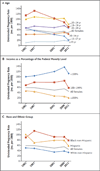Declines in Unintended Pregnancy in the United States, 2008-2011
- PMID: 26962904
- PMCID: PMC4861155
- DOI: 10.1056/NEJMsa1506575
Declines in Unintended Pregnancy in the United States, 2008-2011
Abstract
Background: The rate of unintended pregnancy in the United States increased slightly between 2001 and 2008 and is higher than that in many other industrialized countries. National trends have not been reported since 2008.
Methods: We calculated rates of pregnancy for the years 2008 and 2011 according to women's and girls' pregnancy intentions and the outcomes of those pregnancies. We obtained data on pregnancy intentions from the National Survey of Family Growth and a national survey of patients who had abortions, data on births from the National Center for Health Statistics, and data on induced abortions from a national census of abortion providers; the number of miscarriages was estimated using data from the National Survey of Family Growth.
Results: Less than half (45%) of pregnancies were unintended in 2011, as compared with 51% in 2008. The rate of unintended pregnancy among women and girls 15 to 44 years of age declined by 18%, from 54 per 1000 in 2008 to 45 per 1000 in 2011. Rates of unintended pregnancy among those who were below the federal poverty level or cohabiting were two to three times the national average. Across population subgroups, disparities in the rates of unintended pregnancy persisted but narrowed between 2008 and 2011; the incidence of unintended pregnancy declined by more than 25% among girls who were 15 to 17 years of age, women who were cohabiting, those whose incomes were between 100% and 199% of the federal poverty level, those who did not have a high school education, and Hispanics. The percentage of unintended pregnancies that ended in abortion remained stable during the period studied (40% in 2008 and 42% in 2011). Among women and girls 15 to 44 years of age, the rate of unintended pregnancies that ended in birth declined from 27 per 1000 in 2008 to 22 per 1000 in 2011.
Conclusions: After a previous period of minimal change, the rate of unintended pregnancy in the United States declined substantially between 2008 and 2011, but unintended pregnancies remained most common among women and girls who were poor and those who were cohabiting. (Funded by the Susan Thompson Buffett Foundation and the National Institutes of Health.).
Figures



Similar articles
-
Unintended pregnancy in the United States: incidence and disparities, 2006.Contraception. 2011 Nov;84(5):478-85. doi: 10.1016/j.contraception.2011.07.013. Epub 2011 Aug 24. Contraception. 2011. PMID: 22018121 Free PMC article.
-
Shifts in intended and unintended pregnancies in the United States, 2001-2008.Am J Public Health. 2014 Feb;104 Suppl 1(Suppl 1):S43-8. doi: 10.2105/AJPH.2013.301416. Epub 2013 Dec 19. Am J Public Health. 2014. PMID: 24354819 Free PMC article.
-
Unintended pregnancy in the United States.Fam Plann Perspect. 1998 Jan-Feb;30(1):24-9, 46. Fam Plann Perspect. 1998. PMID: 9494812
-
Understanding U.S. fertility: continuity and change in the National Survey of Family Growth, 1988-1995.Fam Plann Perspect. 1996 Jan-Feb;28(1):4-12. Fam Plann Perspect. 1996. PMID: 8822409 Review.
-
Epidemiology of unintended pregnancy and contraceptive use.Am J Obstet Gynecol. 1994 May;170(5 Pt 2):1485-9. doi: 10.1016/s0002-9378(94)05008-8. Am J Obstet Gynecol. 1994. PMID: 8178895 Review.
Cited by
-
Bias due to Selection on Live Births in Studies of Environmental Exposures during Pregnancy: A Simulation Study.Environ Health Perspect. 2021 Apr;129(4):47001. doi: 10.1289/EHP7961. Epub 2021 Apr 1. Environ Health Perspect. 2021. PMID: 33793300 Free PMC article.
-
Disparities in postpartum contraceptive use among immigrant women with restricted Medicaid benefits.AJOG Glob Rep. 2021 Nov 3;2(1):100030. doi: 10.1016/j.xagr.2021.100030. eCollection 2022 Feb. AJOG Glob Rep. 2021. PMID: 36274968 Free PMC article.
-
Unintended Pregnancy and Abortion in the US Navy, 2016.J Gen Intern Med. 2022 Sep;37(Suppl 3):679-684. doi: 10.1007/s11606-022-07582-6. Epub 2022 Aug 31. J Gen Intern Med. 2022. PMID: 36045191 Free PMC article.
-
Adolescent Women's Sexual Self-Efficacy: Associations with Personal and Perceived Partner Beliefs that Condoms Interfere with Pleasure.Am J Sex Educ. 2020;15(3):336-356. doi: 10.1080/15546128.2020.1763882. Epub 2020 May 28. Am J Sex Educ. 2020. PMID: 38264627 Free PMC article.
-
Association of Patient and Site-of-Care Characteristics With Reproductive Carrier Screening Timing in a Large Integrated Health System.JAMA Netw Open. 2022 Nov 1;5(11):e2240829. doi: 10.1001/jamanetworkopen.2022.40829. JAMA Netw Open. 2022. PMID: 36346628 Free PMC article.
References
-
- Axinn WG, Barber JS, Thornton A. The long-term impact of parents’ childbearing decisions on children’s self-esteem. Demography. 1998;35:435–443. - PubMed
-
- Barber JS, Axinn WG, Thornton A. Unwanted childbearing, health, and mother-child relationships. J Health Soc Behav. 1999;40:231–257. - PubMed
-
- Dott M, Rasmussen SA, Hogue CJ, Reefhuis J. Association between pregnancy intention and reproductive-health related behaviors before and after pregnancy recognition, National Birth Defects Prevention Study, 1997–2002. Matern Child Health J. 2010;14:373–381. - PubMed
Publication types
MeSH terms
Grants and funding
LinkOut - more resources
Full Text Sources
Other Literature Sources
Medical
